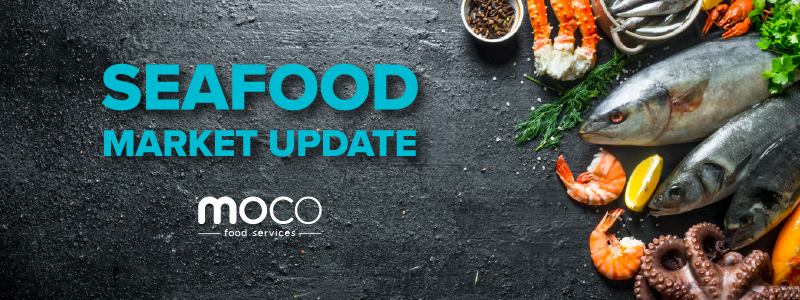Seafood Market Update

With multiple years of challenging conditions, there is some positive news in key sectors of the seafood market, while others remain challenging. Domestically there have been some price reductions on Barramundi and prawns, and its always great when you can put Australian produce on your menu.
Overall, the traded Seafood market has seen prices soften on many products, however, this is being offset by the weaker Australian dollar which has ensured prices remain stable.
Prawns
- Australia has had one of the best prawn seasons in living memory, helping to counter inflationary pressures on pricing
- The price of imported smaller prawns has declined, as a result of the higher-than-usual demand for larger prawns in the Chinese market
Significant domestic rainfall has helped to produce a bumper prawn season with local supply in good stock across all ranges and sizes.
The Chinese market, which has started reopening after COVID-19, is currently showing a high demand for larger-sized prawns. As a result, the prices for larger prawns are higher compared to the same period last year.
The pricing for smaller prawns, on the other hand, decreased by approximately 10% from February to March. It is expected that the price will continue to decline until around May if the prawn farming situation remains stable. From June onwards, the pricing is anticipated to gradually increase.
Barramundi
- The upside of the high rainfall domestically is that juvenile barramundi have grown quicker and they're ready to harvest, resulting in a decrease in prices
- A longer winter has slowed the growth of imported Barraamundi, with harvest to commence a month later than usual
Domestic Wild Caught
Heavy rainfall in the Gulf of Carpentaria from January to March affected fishing operations, leading most fishing operations to delay putting nets in the water. The wet season runoff has contributed to the growth of juvenile Barramundi, making them larger than usual and ready for harvesting. This season is currently looking excellent, with no concerns about the continuity of supply.
Imported
The longer winter season this year has resulted in slower growth of Barramundi. Normally, the main harvest season occurs from June to August, but this year it is expected to begin in late July. This delay is likely to cause a shortage of larger-sized fish during the next harvest season.
Oysters
- Production of NZ oysters is expected to be down almost 50%, placing pressure on prices
- Despite a stable supply of NZ oysters, labour shortages and cyclone Gabrielle have significantly reduced processing capacity
The stock levels of New Zealand oysters have experienced minimal changes in the past few months. However, labour shortages and the impacts of Cyclone Gabrielle have significantly reduced the supply capacity. Currently, less than 2,000 dozen frozen half-shell oysters are being produced per week between two production factories. The availability of standard and medium-sized oysters is very limited. Nevertheless, the production and labour shortages are expected to improve, leading to increased availability of large and jumbo-sized oysters.
The remaining stock for FY22-23 has been reduced by almost 50%, which poses challenges for the New Zealand oyster market. Consequently, prices will remain higher than usual.